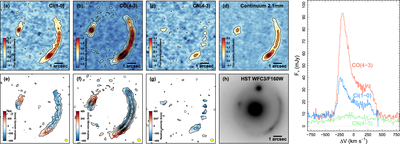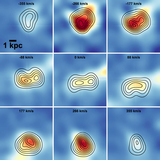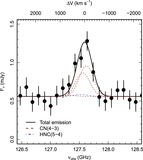Image Details

Caption: Figure 1.
ALMA observations of 9io9. Panels (a)–(c) show the velocity-averaged continuum-subtracted C I (1 → 0), CO (J = 4 → 3) and CN (N = 4 → 3) maps, respectively, and panel (d) shows the 2.1 mm continuum. In panels (a)–(d) contours start at 100 μJy beam−1 and increase in steps of 200 μJy beam−1. Panels (e)–(g) show the C I (1 → 0), CO (J = 4 → 3), and CN (N = 4 → 3) velocity fields derived from the first moment maps, where the blue-to-red color scale spans −400 < ΔV < 400 km s−1 (black contours are the flux density contours in (a)–(c). The yellow ellipse indicates the size and shape of the synthesized beam. Panel (h) shows the archival Hubble Space Telescope 1600 nm (WFC3/F160W) image of the target (data acquired from The Mikulski Archive for Space Telescopes, proposal ID 14653), showing the partial Einstein ring of the background galaxy and the two foreground lensing galaxies: a z ≈ 0.2 elliptical and a smaller northern companion, which has similar color and is assumed to be at the same redshift. All images are orientated north up, east left. The plot on the right shows the galaxy-integrated C I (1 → 0), CO (J = 4 → 3) and CN (N = 4 → 3) spectra, including continuum contribution. The asymmetric double-horned profile of C I (1 → 0) and CO (J = 4 → 3) are consistent with the lower spectral resolution observations of CO (J = 3 → 2) in 9io9 by Harrington et al. (2016).
Copyright and Terms & Conditions
© 2018. The American Astronomical Society. All rights reserved.






